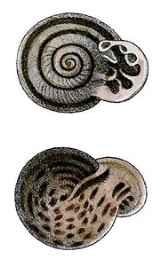
Ringicella carinatum
Encyclopedia
Ringicella carinatum is a species
of air-breathing land snail
, a terrestrial
pulmonate gastropod mollusk in the subfamily Bulimulinae, in the family Orthalicidae
.
Pilsbry (1901) mentioned Ringicella carinatum as also occurring in Colombia
, in high forest
s of the Magdalena river
basin at 1830 m (6000 feet) above sea level, but Vera Ardila (2008) considers the presence of the species in Colombia to be doubtful.
of this species has a long basal suture. It is conoid-lenticular, rather solid, acutely carinate. It is pale in color, narrowly banded with chestnut above the keel and at the suture. The spire
is shortly conoid in shape. The shell has 5 whorls
which are rather flattened; the upper ones are striatulate, the final whorl
with irregular and waved rib-striae. The base of the shell is convex, spotted with chestnut, scrobiculate in front.
The shell aperture
follows the slope of the spire, is semicircular, and is contracted by six strong, curved lamellae. The peristome is white, broadly expanded and reflexed. The right margin of the peristome is provided with a large foramen at its insertion point.
The width of adult shells is 24.5 mm, the height is 13 mm.
Species
In biology, a species is one of the basic units of biological classification and a taxonomic rank. A species is often defined as a group of organisms capable of interbreeding and producing fertile offspring. While in many cases this definition is adequate, more precise or differing measures are...
of air-breathing land snail
Snail
Snail is a common name applied to most of the members of the molluscan class Gastropoda that have coiled shells in the adult stage. When the word is used in its most general sense, it includes sea snails, land snails and freshwater snails. The word snail without any qualifier is however more often...
, a terrestrial
Terrestrial animal
Terrestrial animals are animals that live predominantly or entirely on land , as compared with aquatic animals, which live predominantly or entirely in the water , or amphibians, which rely on a combination of aquatic and terrestrial habitats...
pulmonate gastropod mollusk in the subfamily Bulimulinae, in the family Orthalicidae
Orthalicidae
Orthalicidae are a family of tropical air-breathing land snails, terrestrial pulmonate gastropod mollusks are classified in the informal group Sigmurethra of the clade Stylommatophora...
.
Distribution
This species occurs in Brazil.Pilsbry (1901) mentioned Ringicella carinatum as also occurring in Colombia
Colombia
Colombia, officially the Republic of Colombia , is a unitary constitutional republic comprising thirty-two departments. The country is located in northwestern South America, bordered to the east by Venezuela and Brazil; to the south by Ecuador and Peru; to the north by the Caribbean Sea; to the...
, in high forest
High forest (woodland)
High forest is a term for a woodland or forest with a well-developed natural structure. It is used in both ecology and woodland management, particularly in contrast with even-aged woodland types such as coppice and planted woodland....
s of the Magdalena river
Magdalena River
The Magdalena River is the principal river of Colombia, flowing northward about through the western half of the country. It takes its name from the biblical figure Mary Magdalene. It is navigable through much of its lower reaches, in spite of the shifting sand bars at the mouth of its delta, as...
basin at 1830 m (6000 feet) above sea level, but Vera Ardila (2008) considers the presence of the species in Colombia to be doubtful.
Shell description
The shellGastropod shell
The gastropod shell is a shell which is part of the body of a gastropod or snail, one kind of mollusc. The gastropod shell is an external skeleton or exoskeleton, which serves not only for muscle attachment, but also for protection from predators and from mechanical damage...
of this species has a long basal suture. It is conoid-lenticular, rather solid, acutely carinate. It is pale in color, narrowly banded with chestnut above the keel and at the suture. The spire
Spire (mollusc)
A spire is a descriptive term for part of the coiled shell of mollusks. The word is a convenient aid in describing shells, but it does not refer to a very precise part of shell anatomy: the spire consists of all of the whorls except for the body whorl...
is shortly conoid in shape. The shell has 5 whorls
Whorl (mollusc)
A whorl is a single, complete 360° revolution or turn in the spiral growth of a mollusc shell. A spiral configuration of the shell is found in of numerous gastropods, but it is also found in shelled cephalopods including Nautilus, Spirula and the large extinct subclass of cephalopods known as the...
which are rather flattened; the upper ones are striatulate, the final whorl
Body whorl
Body whorl is part of the morphology of a coiled gastropod mollusk.- In gastropods :In gastropods, the body whorl, or last whorl, is the most recently-formed and largest whorl of a spiral or helical shell, terminating in the aperture...
with irregular and waved rib-striae. The base of the shell is convex, spotted with chestnut, scrobiculate in front.
The shell aperture
Aperture (mollusc)
The aperture is an opening in certain kinds of mollusc shells: it is the main opening of the shell, where part of the body of the animal emerges for locomotion, feeding, etc....
follows the slope of the spire, is semicircular, and is contracted by six strong, curved lamellae. The peristome is white, broadly expanded and reflexed. The right margin of the peristome is provided with a large foramen at its insertion point.
The width of adult shells is 24.5 mm, the height is 13 mm.
External links
- Four views of one shell of Ringicella carinata: http://www.wretch.cc/album/show.php?i=pjwang&b=87&f=1173363568&p=13

